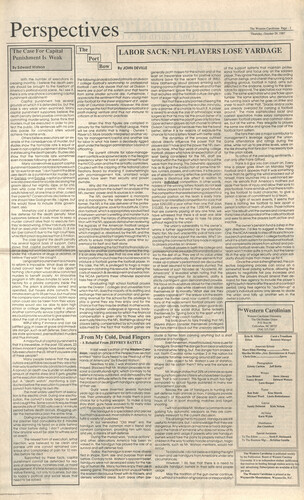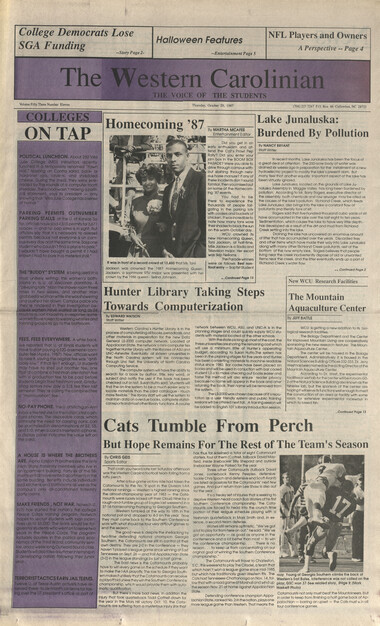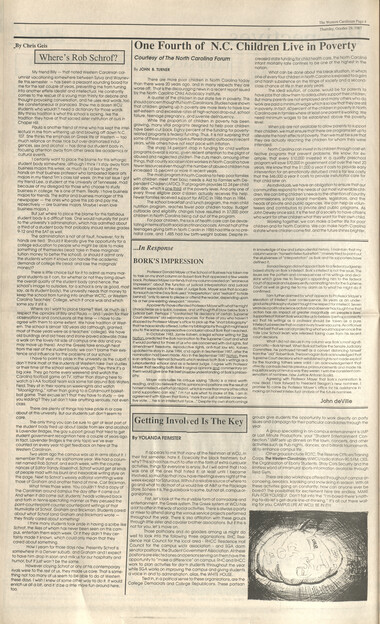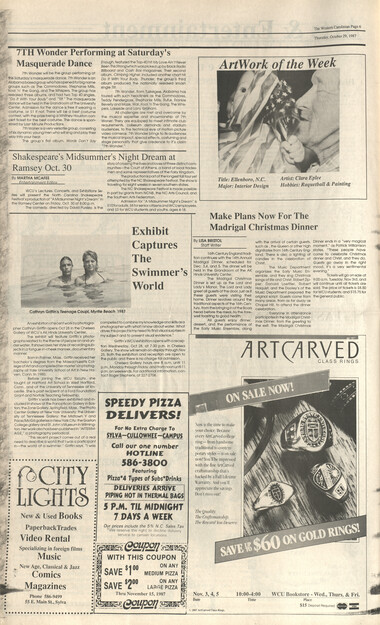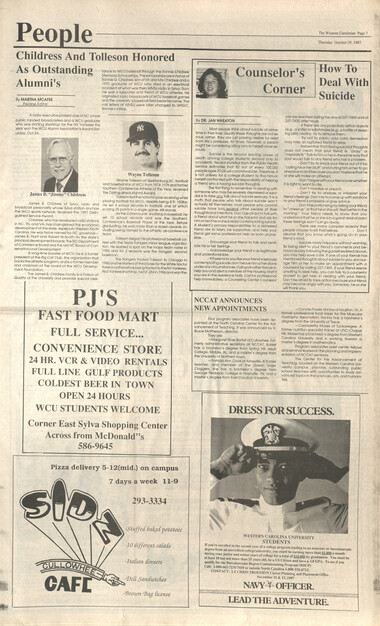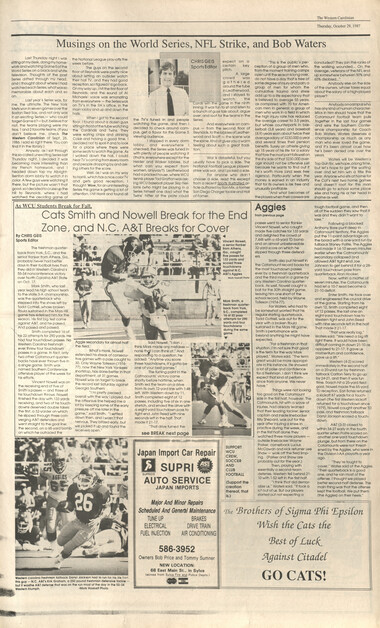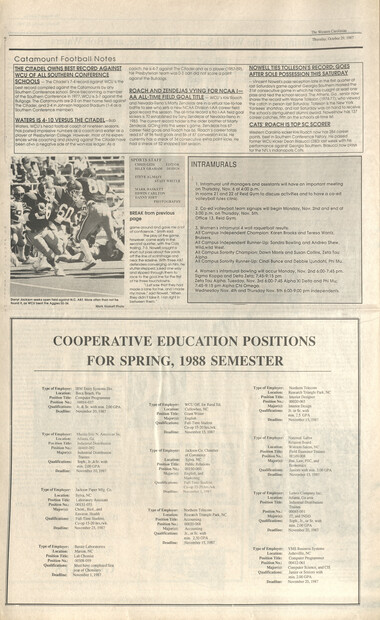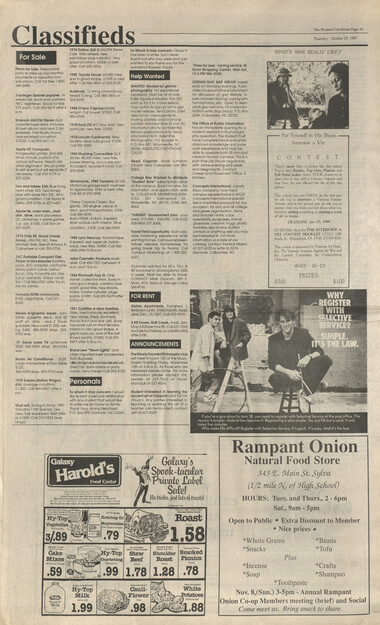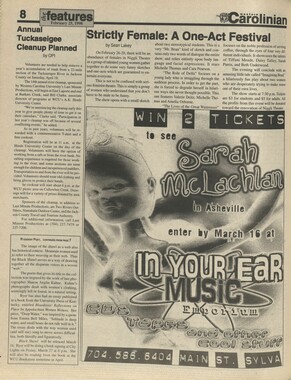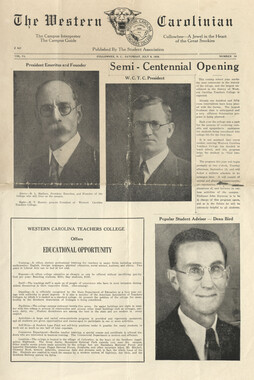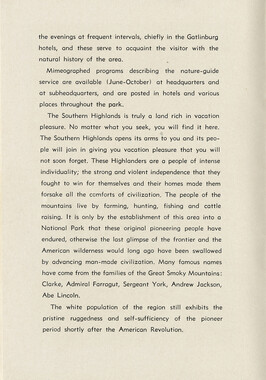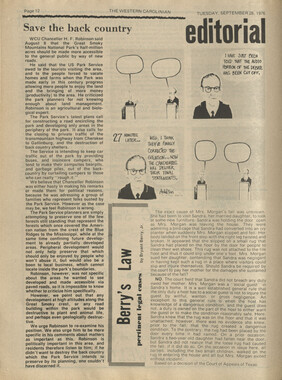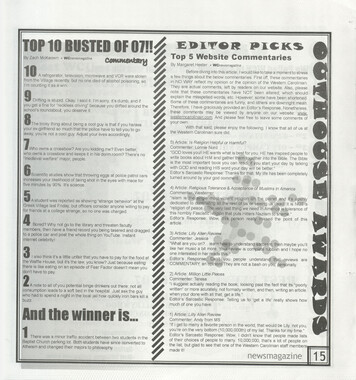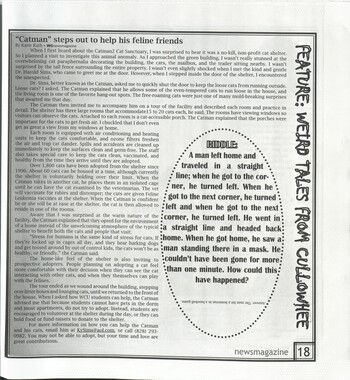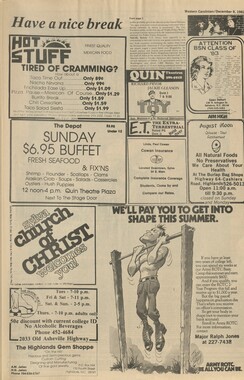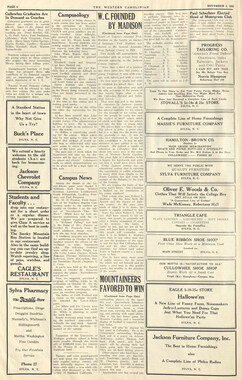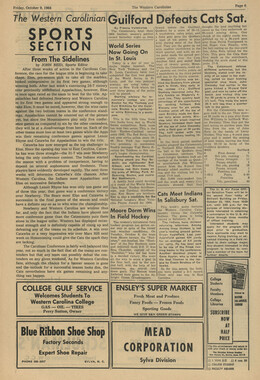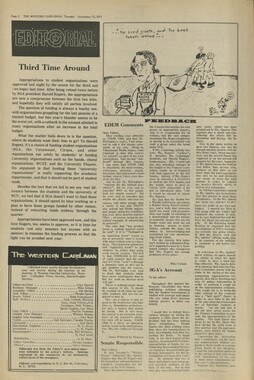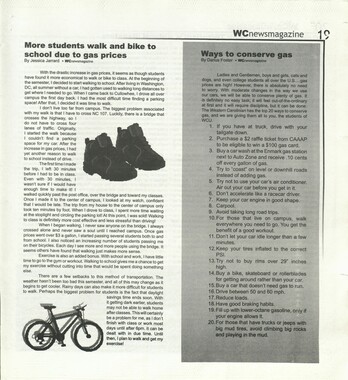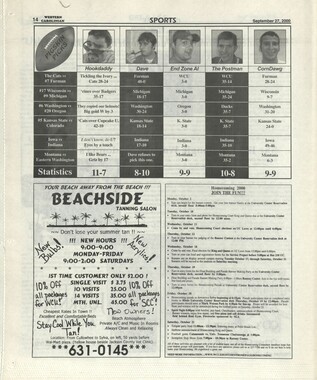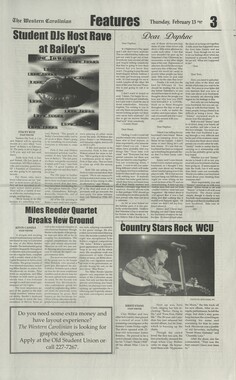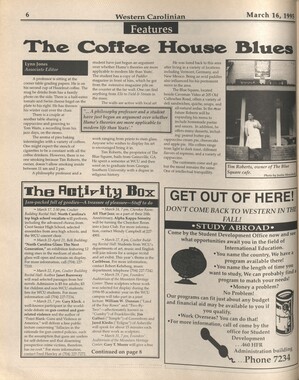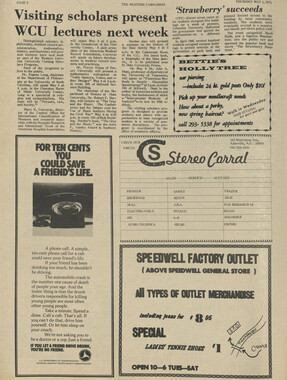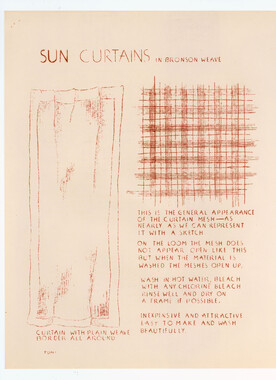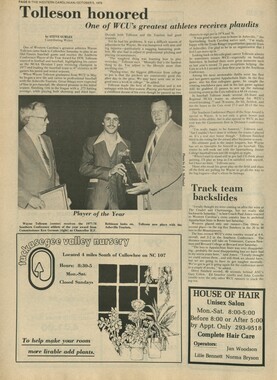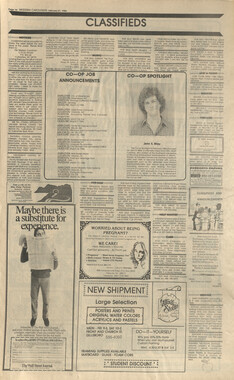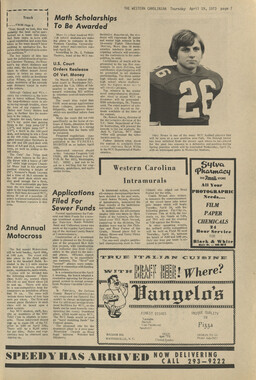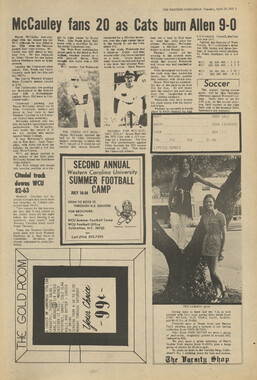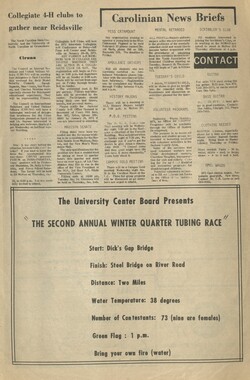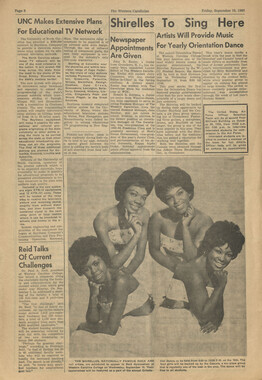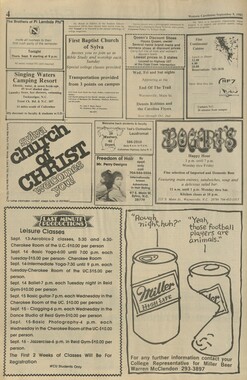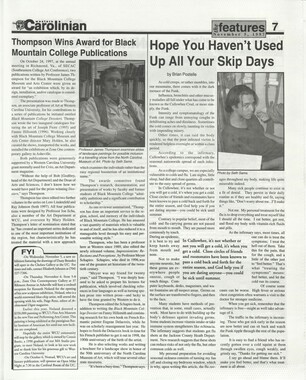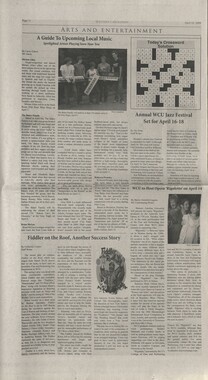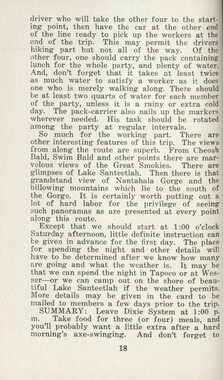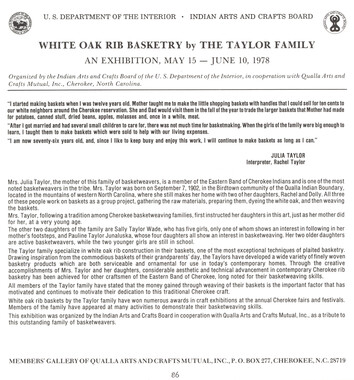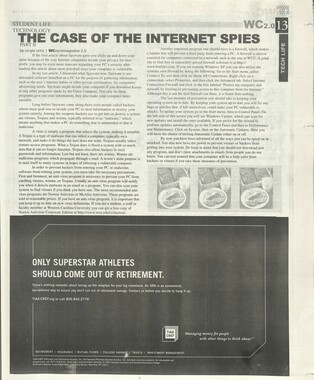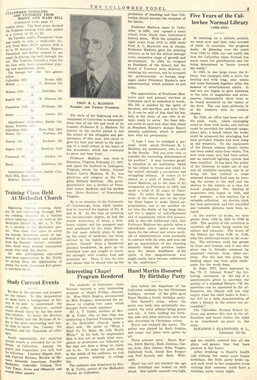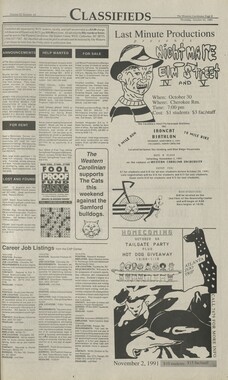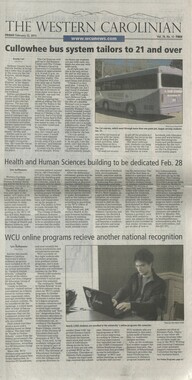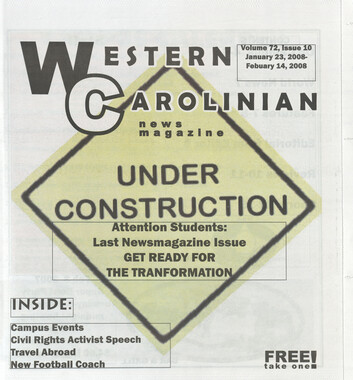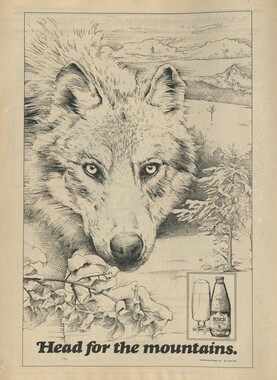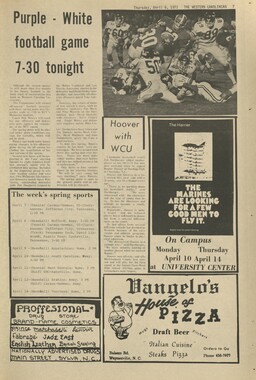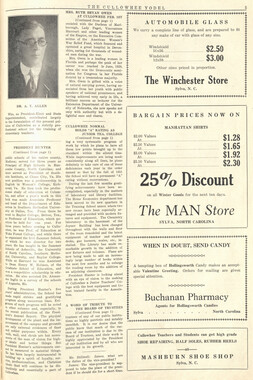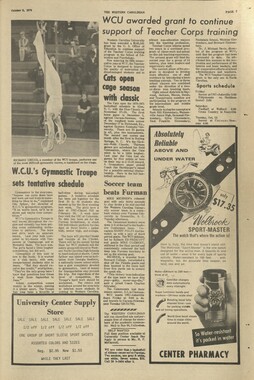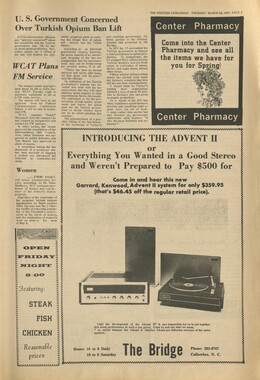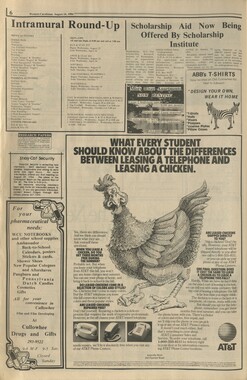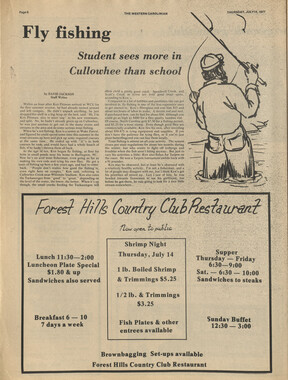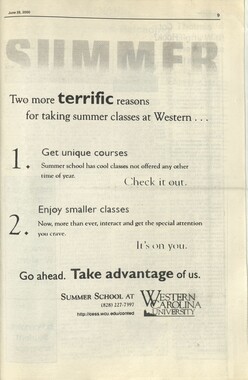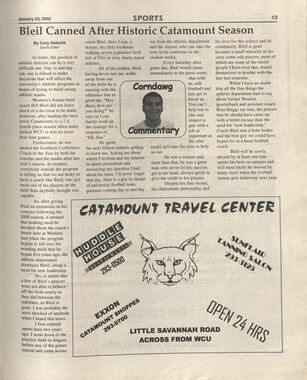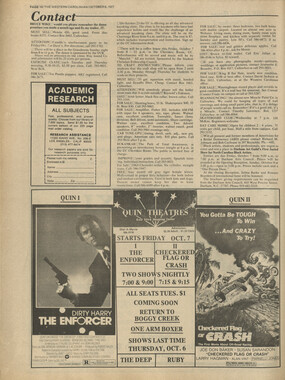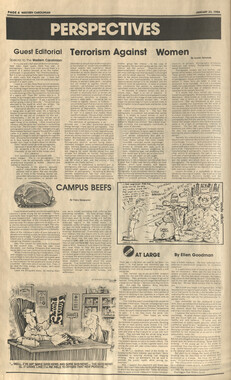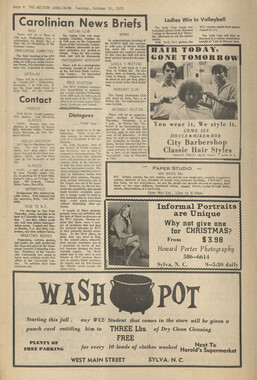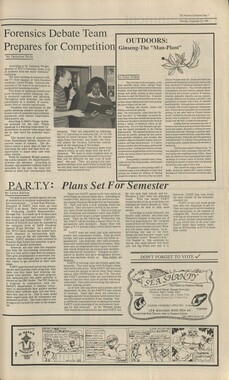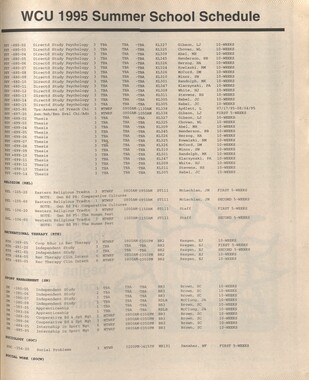Western Carolina University (21)
View all
- Canton Champion Fibre Company (2308)
- Cherokee Traditions (291)
- Civil War in Southern Appalachia (165)
- Craft Revival (1942)
- George Masa Collection (137)
- Great Smoky Mountains - A Park for America (3080)
- Highlights from Western Carolina University (422)
- Horace Kephart (973)
- Journeys Through Jackson (159)
- LGBTQIA+ Archive of Jackson County (89)
- Oral Histories of Western North Carolina (318)
- Picturing Appalachia (6617)
- Stories of Mountain Folk (413)
- Travel Western North Carolina (153)
- Western Carolina University Fine Art Museum Vitreograph Collection (129)
- Western Carolina University Herbarium (92)
- Western Carolina University: Making Memories (738)
- Western Carolina University Publications (2491)
- Western Carolina University Restricted Electronic Theses and Dissertations (146)
- Western North Carolina Regional Maps (71)
- World War II in Southern Appalachia (131)
University of North Carolina Asheville (6)
View all
- Allanstand Cottage Industries (62)
- Appalachian National Park Association (53)
- Bennett, Kelly, 1890-1974 (1463)
- Berry, Walter (76)
- Brasstown Carvers (40)
- Carver, George Washington, 1864?-1943 (26)
- Cathey, Joseph, 1803-1874 (1)
- Champion Fibre Company (233)
- Champion Paper and Fibre Company (297)
- Cherokee Indian Fair Association (16)
- Cherokee Language Program (22)
- Crowe, Amanda (40)
- Edmonston, Thomas Benton, 1842-1907 (7)
- Ensley, A. L. (Abraham Lincoln), 1865-1948 (275)
- Fromer, Irving Rhodes, 1913-1994 (70)
- George Butz (BFS 1907) (46)
- Goodrich, Frances Louisa (120)
- Grant, George Alexander, 1891-1964 (96)
- Heard, Marian Gladys (60)
- Kephart, Calvin, 1883-1969 (15)
- Kephart, Horace, 1862-1931 (313)
- Kephart, Laura, 1862-1954 (67)
- Laney, Gideon Thomas, 1889-1976 (439)
- Masa, George, 1881-1933 (61)
- McElhinney, William Julian, 1896-1953 (44)
- Niggli, Josephina, 1910-1983 (10)
- North Carolina Park Commission (105)
- Osborne, Kezia Stradley (9)
- Owens, Samuel Robert, 1918-1995 (11)
- Penland Weavers and Potters (36)
- Roberts, Vivienne (15)
- Roth, Albert, 1890-1974 (142)
- Schenck, Carl Alwin, 1868-1955 (1)
- Sherrill's Photography Studio (2565)
- Southern Highland Handicraft Guild (127)
- Southern Highlanders, Inc. (71)
- Stalcup, Jesse Bryson (46)
- Stearns, I. K. (213)
- Thompson, James Edward, 1880-1976 (226)
- United States. Indian Arts and Crafts Board (130)
- USFS (683)
- Vance, Zebulon Baird, 1830-1894 (1)
- Weaver, Zebulon, 1872-1948 (58)
- Western Carolina College (230)
- Western Carolina Teachers College (282)
- Western Carolina University (2008)
- Western Carolina University. Mountain Heritage Center (18)
- Whitman, Walt, 1819-1892 (10)
- Wilburn, Hiram Coleman, 1880-1967 (73)
- Williams, Isadora (3)
- Cain, Doreyl Ammons (0)
- Crittenden, Lorraine (0)
- Rhodes, Judy (0)
- Smith, Edward Clark (0)
- Appalachian Region, Southern (3032)
- Asheville (N.C.) (1945)
- Avery County (N.C.) (26)
- Blount County (Tenn.) (195)
- Buncombe County (N.C.) (1680)
- Cherokee County (N.C.) (283)
- Clay County (N.C.) (556)
- Graham County (N.C.) (238)
- Great Smoky Mountains National Park (N.C. and Tenn.) (525)
- Haywood County (N.C.) (3573)
- Henderson County (N.C.) (70)
- Jackson County (N.C.) (4925)
- Knox County (Tenn.) (35)
- Knoxville (Tenn.) (13)
- Lake Santeetlah (N.C.) (10)
- Macon County (N.C.) (421)
- Madison County (N.C.) (216)
- McDowell County (N.C.) (39)
- Mitchell County (N.C.) (135)
- Polk County (N.C.) (35)
- Qualla Boundary (982)
- Rutherford County (N.C.) (78)
- Swain County (N.C.) (2185)
- Transylvania County (N.C.) (270)
- Watauga County (N.C.) (12)
- Waynesville (N.C.) (86)
- Yancey County (N.C.) (72)
- Aerial Photographs (3)
- Aerial Views (60)
- Albums (books) (4)
- Articles (1)
- Artifacts (object Genre) (228)
- Bibliographies (1)
- Biography (general Genre) (2)
- Cards (information Artifacts) (38)
- Clippings (information Artifacts) (192)
- Copybooks (instructional Materials) (3)
- Crafts (art Genres) (622)
- Depictions (visual Works) (21)
- Design Drawings (1)
- Digital Moving Image Formats (2)
- Drawings (visual Works) (185)
- Envelopes (101)
- Exhibitions (events) (1)
- Facsimiles (reproductions) (1)
- Fiction (general Genre) (4)
- Financial Records (12)
- Fliers (printed Matter) (67)
- Glass Plate Negatives (381)
- Guidebooks (2)
- Internegatives (10)
- Interviews (823)
- Land Surveys (102)
- Letters (correspondence) (1045)
- Manuscripts (documents) (618)
- Maps (documents) (177)
- Memorandums (25)
- Minutes (administrative Records) (59)
- Negatives (photographs) (6090)
- Newsletters (1290)
- Newspapers (2)
- Notebooks (8)
- Occupation Currency (1)
- Paintings (visual Works) (1)
- Pen And Ink Drawings (1)
- Periodicals (194)
- Personal Narratives (10)
- Photographs (12977)
- Plans (maps) (1)
- Poetry (6)
- Portraits (4568)
- Postcards (329)
- Programs (documents) (181)
- Publications (documents) (2444)
- Questionnaires (65)
- Relief Prints (26)
- Sayings (literary Genre) (1)
- Scrapbooks (282)
- Sheet Music (2)
- Slides (photographs) (402)
- Songs (musical Compositions) (2)
- Sound Recordings (802)
- Specimens (92)
- Speeches (documents) (18)
- Tintypes (photographs) (8)
- Transcripts (329)
- Text Messages (0)
- A.L. Ensley Collection (275)
- Appalachian Industrial School Records (7)
- Appalachian National Park Association Records (336)
- Axley-Meroney Collection (2)
- Bayard Wootten Photograph Collection (20)
- Bethel Rural Community Organization Collection (7)
- Blumer Collection (5)
- C.W. Slagle Collection (20)
- Canton Area Historical Museum (2110)
- Carlos C. Campbell Collection (462)
- Cataloochee History Project (64)
- Cherokee Studies Collection (4)
- Daisy Dame Photograph Album (5)
- Daniel Boone VI Collection (1)
- Doris Ulmann Photograph Collection (112)
- Elizabeth H. Lasley Collection (1)
- Elizabeth Woolworth Szold Fleharty Collection (4)
- Frank Fry Collection (95)
- George Masa Collection (173)
- Gideon Laney Collection (452)
- Hazel Scarborough Collection (2)
- Hiram C. Wilburn Papers (28)
- Historic Photographs Collection (236)
- Horace Kephart Collection (861)
- Humbard Collection (33)
- Hunter and Weaver Families Collection (1)
- I. D. Blumenthal Collection (4)
- Isadora Williams Collection (4)
- Jesse Bryson Stalcup Collection (47)
- Jim Thompson Collection (224)
- John B. Battle Collection (7)
- John C. Campbell Folk School Records (80)
- John Parris Collection (6)
- Judaculla Rock project (2)
- Kelly Bennett Collection (1482)
- Love Family Papers (11)
- Major Wiley Parris Civil War Letters (3)
- Map Collection (12)
- McFee-Misemer Civil War Letters (34)
- Mountain Heritage Center Collection (4)
- Norburn - Robertson - Thomson Families Collection (44)
- Pauline Hood Collection (7)
- Pre-Guild Collection (2)
- Qualla Arts and Crafts Mutual Collection (12)
- R.A. Romanes Collection (681)
- Rosser H. Taylor Collection (1)
- Samuel Robert Owens Collection (94)
- Sara Madison Collection (144)
- Sherrill Studio Photo Collection (2558)
- Smoky Mountains Hiking Club Collection (616)
- Stories of Mountain Folk - Radio Programs (374)
- The Reporter, Western Carolina University (510)
- Venoy and Elizabeth Reed Collection (16)
- WCU Gender and Sexuality Oral History Project (36)
- WCU Mountain Heritage Center Oral Histories (25)
- WCU Oral History Collection - Mountain People, Mountain Lives (71)
- WCU Students Newspapers Collection (1923)
- Western North Carolina Tomorrow Black Oral History Project (69)
- William Williams Stringfield Collection (2)
- Zebulon Weaver Collection (109)
- African Americans (390)
- Appalachian Trail (35)
- Artisans (521)
- Cherokee art (84)
- Cherokee artists -- North Carolina (10)
- Cherokee language (21)
- Cherokee pottery (101)
- Cherokee women (208)
- Church buildings (190)
- Civilian Conservation Corps (U.S.) (111)
- College student newspapers and periodicals (2012)
- Dams (108)
- Dance (1023)
- Education (222)
- Floods (63)
- Folk music (1015)
- Forced removal, 1813-1903 (2)
- Forest conservation (220)
- Forests and forestry (1198)
- Gender nonconformity (4)
- Great Smoky Mountains National Park (N.C. and Tenn.) (181)
- Hunting (47)
- Landscape photography (25)
- Logging (122)
- Maps (83)
- Mines and mineral resources (9)
- North Carolina -- Maps (18)
- Paper industry (38)
- Postcards (255)
- Pottery (135)
- Railroad trains (72)
- Rural electrification -- North Carolina, Western (3)
- School integration -- Southern States (2)
- Segregation -- North Carolina, Western (5)
- Slavery (5)
- Sports (452)
- Storytelling (243)
- Waterfalls -- Great Smoky Mountains (N.C. and Tenn.) (66)
- Weaving -- Appalachian Region, Southern (280)
- Wood-carving -- Appalachian Region, Southern (328)
- World War, 1939-1945 (173)
Western Carolinian Volume 53 Number 11
Item
Item’s are ‘child’ level descriptions to ‘parent’ objects, (e.g. one page of a whole book).
-
-
Perspectives The Western Carolinian Page - 3 Thursday, October 29,1987 The Case For Capital Punishment Is Weak By Edward Watson The Port With the number of executions increasing monthly, I believe the death penalty should be brought to the forefront of America's political-social scene. As I see it, there is only one choice concerning capital punishment-abolishment! Capital punishment has several grounds on which it is defended by, but the base is very weak when examined. Many capital punishment supporters believe the death penalty deters possible criminals from committing murder-wrong. Some think that murders must be executed in order to protect the public. Life sentences with no possible parole for convicted killers would achieve the same ends. Others believe executions set an example of the consequences of murder, but studies show the homicide rate is equal or lower in non-capital punishment states than in states using the death penalty. Studies also show that the homicide rate sometimes even increases following an execution. Many conservatives support capital punishment based on biblical scriptures such as "an eye for an eye. "I don't admit the B/b/e uses death as a punishment for murder, but in Genesis and Exodus capital punishment was also prescribed for a bride deceiving the groom about her virginity, rape, or for children who curse their parents. How many adults have not, at one time or other, cursed their parents? Conservatives also believe no one should take God-given life. I agree, but this would have to include state government, also. Monetary cost is another conservative defense for the death penalty. Most supporters believe it costs more to keep a murder convict alive than to execute him- they' re dead wrong. A New York study states that an execution costs the public $1.8 million (per convict) due to the high court fees, while life in prison requires lessthan $.9 million. The case against the death penalty has several logical basis of support. Data shows that capital punishment as deterrence does not work because most killers are under the influence of drugs or alcohol, or believe they won't be caught. Using capital punishment as a means to reform is impossible. What does an executed convict learn that he can apply? Nothing. Life in prison would allow convicted murders to benefit society. An innovative program in MN allows inmates to work in a factory for a private company inside the prison. The prison is privately owned and operated, but houses state convicts. The inmates earn up to $8 per hour, but must pay the company room and board. Victim reparation could also be taken from their salary. Inmates would also be able to earn high school or college degrees while in prison. Another community service capital offenders could provide would be to give speeches about the cost of crime to students. Willful killing if immoral and can be justified only in cases of grave and immediate danger, such as self defense. Executions are state sponsored, premeditated murders and thus immoral. A majorfault of capital punishment is that it is irreversible. In the past 100 years, 23 known innocent people have been wrongfully executed in the US. What if you were one of these people? Many people believe that the executions are justifiable because they are a human way to exterminate convicted murders. A convict on death row is under an extreme amount of mental stress and it gets greater asthe execution date nears and appeals run out. A "death watch" monitoring is conducted before the execution to prevent the convict from taking his own life. The most widely used form of execution is the electric chair. During one electrocution, the convict's body began to swell and caught fire. Some convicts require three separate jolts of 19,000 volts over a 14minute period before death occurs, struggling under the tremendous pain the entire time. During one gas chamber execution., the prisoner had convulsions for 8 minutes while slamming his head on a pole behind the chair before dying. I don't understand how anyone would be able to witness such an event. The newest form of execution, lethal injection, was believed to be clean and painless until one convict remained conscious and complained of pain for 10 minutes before he died. Supported by these facts, capital punishment cannot be defended for reasons of deterrence, monetary cost, or moral requirement. It's time America applied innovative thinking, not only to business, but also to today's political and social issues that need to be solved. LABOR SACK: NFL PLAYERS LOSE YARDAGE Bow By JOHN DEVILLE The following analysis is based primarily on division 1 college football's relationship to professional football. I am fully aware that not all Division 1 teams are a part of this system and that teams from some smaller schools are. Furthermore, I appreciate the sentiment that many young men play football for the sheer enjoyment of it, especially at Columbia University. However, this does not change the fact that professional football is a profit-making venture and thus not immune to criticism of its economic practices. When the final figures are compiled in January for the National Football League, there will be one statistic that is missing - Owners 1, Player's 0. More broadly interpreted another victory for management/capital and another loss for labor in what has been a decidedly rigged sport underthe Reagan administration's brand of officiating. The current climate for labor-management conflicts was spawned early in the Reagan presidency when he took it upon himself to bust the PATCO union and fire the airtraffic controllers. Coupled with the crippling of the National Labor Relations Board by stacking it overwhelmingly with pro-management folk, unionized wage earners have seen their security and power dwindle. Why did the players lose? Why was the strike doomed from the outset? An analysis of the NFL owners' power and its sources is in order. The NFL owners represent a monopoly and a monopsony, the latter derived from the former. The NFL is the sole deliverer of the professional football game, save for its substitute, Canadian football, which is appropriately sandwiched in between women's wrestling and monster truck shows on ESPN. The history of attempted competition with the NFL appears dismal when reviewing the legacies of the American Football League and the United States Football League, the first of which merged i.e. absorbed, by the NFL and the second bankrupted by it largely through the NFL's efforts to ensure major-network, prime time supremacy for itself and itself alone. Establishing the fact that it isf inancially untenable for another competitor to enter the ring, it is an easy step to see that no one else is in a similar position to purchase the crucial resource to produce a football game-the football player. In this case, the NFL is privileged to forgo a major expense in obtaining this resource, that being the costs of research & development and extraction. The NCAA performs these otherwise expensive tasks free of charge. Graduating high school football players enter the Division 1 colleges and universities from which the NFL does the majority of its drafting and exchange their service of promotion and generating revenue for the school for the privilege to play a game they say they enjoy and for the chance that they may be drafted. In other words, the player/worker undergoes a rigorous, body- smashing training process for which the financial compensation is given only to those who are eventually hired by the NFL. Blatherings about the players being compensated by scholarships are subsumed by the fact that football games are generally profit makers for the school and at the least an inexpensive source for positive school relations (save for the recent fiasco at SMU). More blatherings about players entering such training contract of their own free will andfortheir own enjoyment ignore the gold-plated carrots that recruiters and the football culture dangle in front of eager high school players. Not that there is any promise of seeing the carrot being delivered by the recruiter, mind you, only a promise of a chance to touch it. A player is asked to endure the joys of arthroscopic knee surgery so that he may be the proud owner of a lottery ticket where the payoff goes only to a few. Upper echelon players do not choose to attend Division 1 schools just because they like the band better, rather it is for reasons of exposure-the chance to hold a lottery ticket with better odds. The dynamics of the process outlined above directly influence the power that the players don't have and the power the NFL owners do have. After four years of playing college football, players who have an expectation of at least being considered for the NFL draft are familiar within the the sport which tend to cull the weak from the strong. This Darwinistic approach has as its goal the production of prime-time hitters, runners, passers, and catchers. It is the process of selection among reflective animals which creates a disastrous side effect in relation to unions - individual competition. In other words, holders of the winning lottery tickets do not seek out fellow players to share in their good fortune. The competition that existed among players for a particular position on the team is easily transferred to an intensified competition for a job that pays $250,000 a year rather than one that pays $10,000. For every one of the 1,200 NFL players that are currently playing at any one time, we have witnessed that there is at least one able player waiting in the wings to take his place without regard to the union. The union's vulnerability to the owner's whims is further aggravated by the unsympathetic fan. My own unscientific poll of fans concluded that most support the owners. Why? Unpacking the comments that fans made in regard to players provides an answer. Football players in both the college and professional ranks are subject to standards peculiar to the rest of us. They are of no value unless they perform athletically. All other elements that make up a player's personhood are discounted or at least assumed to be severely stunted. The hollowness of such facades as "Academic All- Americans" is revealed when noting that the athletes' recognition for academic ability is strictly contingent upon demonstrated prowess. This focus on musculature allows for the creation of a gladiator class while observers can assure themselves of its morality-'What else are they possibly capable of?" The answer is in the examination the former (and now current) occupations of the replacement football players: construction laborers, bartenders, prison guards-occupations of low social status. Some redeem themselves by "giving back to the sport what it gave them'-they coach football. This boils down to fans thinking that NFL players should consider themselves privileged. The fans mental block out the unsavory aspects of the support systems that maintain professional football and focus only on the salaried player. They ignore the pollution, the discarding of human beings, and cherish the running back standing glorious, football in hand, arms outstretched in the endzone, looking to the spectators for approval. The spectators roar maniacally. The same spectators who are fickle upon fumble. The same spectators who denounce the running back when he goes on strike and sneer to each other that, "blacks and/or jocks are already overpaid for carrying a football around." The more sophisticated racist and casteist spectators make salary comparisons between football players and common laborers, but all the same, they relegate to players the same low status and ignore the cost of the football farm system. The fans then are a major contributor to management's leverage against the union. Game attendance and ratings during the strike, while not up to pre-strike levels, were on the rise showing that fans don't necessarily look for the union labels. To critics of the preceding sentiments, I can only offer Frank Glfford. Frank is a guy you can count on. Every time a player goes down on Monday Night Football and it appears that it was something more than his getting the wind knocked out of himself, Frank launches into a well-honed sermon. He exhorts that America's mothers put aside their fears of injury and allow their sons to play football. Frank reminds us that there is nothing like football to build character, to give a person a sense of commitment to a team. In light of recent events, it seems that there is nothing like football to tear apart a person's notion of team, of union. Those notions won't be rebuilt until the owners and consumers (fans) take a full appraisal of the costs of football and seek to serve the players both active and inactive. The owner's pension fund is a step in the right direction. I'd like to suggest a few more. One, the NCAA needs to step off its sanctimonious perch and see Division 1 college football for what it is-a farm system for professional football, and compensate players from school and professional football revenues. Those who make a team won't make quite a much, but the benefits in the way of wage security and union solidarity should more than make up for it. Once the union is strengthened .the collective bargaining process can occur on a somewhat level playing surface, allowing the players to negotiate fair pay increases and benefits. The players should amend their demand for free agency to include the player's right to switch teams after the end of a contract period. Using free agency to "auction-up" a player's individual salary only serves to divide the union and tally up another win in the owner's column. rh* Western Carolinian Western Carolinian University The Old Student Union P.O. Box 66 Cullowhee, NC 28723 (704) 227-7267 .From My Cold, Dead Fingers - A Rebuttal From JEFFREY BATTLE In last week's edition of the Western Carolinian, I read an article in the Perspectives section entitled "Hand Guns Need to be Pried out of the Hands of Americans" by Edward Watson. Needless to say, I was shocked and dismayed. Shocked that Mr. Watson proposes to rescind a constitutional right, which contrary to his belief is in no way outdated, and dismayed by the fact that his attitude reflects the very essence of the problem of dealing with handguns: ignorance of their use. Guns were invented several hundred years ago as a supplement for anti-calvary arsenals. Their unreliability at first made them a poor choice for a hunting weapon. To make a long story short, guns have evolved to fill many roles until the products we currently have. The handgun is a specialized and precise tool that has evolved, most notably in America,to fulfill a variety of purposes. In our venerated "Old West" era, the handgun was the common man's friend and constant companion, providing him with food, and yes, a means of self-defense. During the myriad wars, "police-actions", and other altercations America has been involved in, the handgun has played the role of a survival and self-defense tool. Today, the handgun is even more diversified in shape, form, size and purpose than ever before. Contrary to Mr. Watson's apparent belief, handguns were not developed solely for the taking of human life. Many hunters enjoy their use in seeking game. This practice is not unusual here in the eastern deciduous forest with its thickets, and densely wooded areas. Such areas often pre clude a hunter from carrying anything but a short carbine or a handgun. Even fishermen, myself included, have a use for handguns. Granted the dangerfrom bearorwild boar is minimal while fishing, but, the danger from snakes is not. North Carolina ranks number 2 in the nation for snakebite fatalities averaging around 600 per year. I also object to Mr. Watson's use of statistics. Where did he obtain them? Why was the sample so small? Mr. Watson states that 25% of criminals acquire their guns from private citizens who have been burglarized. That is not correct. This figure is much too high compared to actual figures published in many law enforcement journals. Besides the use of handguns in hunting and self-defense from animals or man, randguns provide hundred's of thousands of people each year with hours of fun in sport shooting matches and target shooting. I will not address Mr. Watson's comments on legalizing fully automatic weapons as they are completely irrelevant to the current discussion. This all brings me to my point. Handguns are still useful to Americans, but, I acknowledge that they are dangerous. Any weapon or machine or tool is dangerous in the hands of someone who does not know of its proper care and usage.If parents who are handgun owners would take the pains to properly instruct their children in the way to safely handle a handgun, tragic accidents, such as Mr. Watson mentions, would not occur. To conclude, I do not believe in taking the right to own and use handguns from Americans under any circumstances. However, I do feel that there is a need to educate handgun owners in their safe and proper usage. May the tradition of the gun owner continue, but, without a tradition of ignorance or irresponsibility? Erin H. Millner Editor Carol e Trantham Business Manager Associate Editors Mary Ellen Fleming News Martha McAfee ..Arts, Entertainment & People Chris Geis Sports Photographers Edwin Carlton Jeff Battle Writers Lisa Bristol Steve Almasy Nancy Bryant Edward Watson Lora Hooper Typist Bob Bohl Kim Morris Michael Ward Linda Bodenhamer Layout Sandy Delmont Kirk Nelson Ad Sales Kara Wykle Distribution Jim Crawford Special Assistants To The Editor Scott P. Stalmasek To The Business Mgr Kristina Gentile The Western Carolinian is published weekly by the Publication Board of Western Carolina University. It is an independent student publicatioi i that receives its funding through student activity fe and advertising. Subscriptions are available at $16 per year. The Western Carolinian is printed at the Waynesville Mountaineer, Waynesville, N.C.
Object
Object’s are ‘parent’ level descriptions to ‘children’ items, (e.g. a book with pages).
-
The Western Carolinian is Western Carolina University's student-run newspaper. The paper was published as the Cullowhee Yodel from 1924 to 1931 before changing its name to The Western Carolinian in 1933.
-

